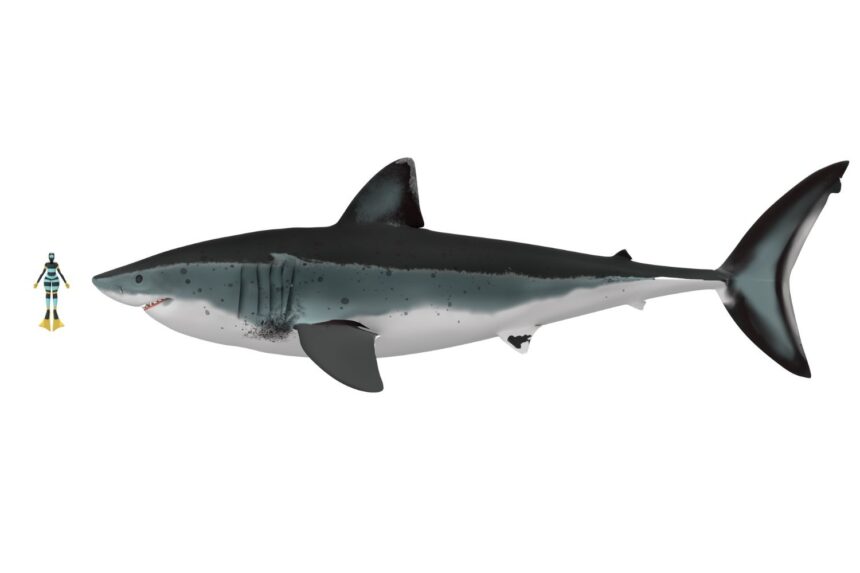15 million years before movies like Jaws and Open Water gave swimmers the heebie-jeebies, a prehistoric shark species called Otodus megalodon reached gargantuan sizes. Researchers have reassessed just how large the now-extinct beast would have been—and the results are fin-tastic.
To refine its own estimates of megalodon’s size, an international team of biologists, paleontologists, and anatomists analyzed partial megalodon fossils alongside the morphology of both existing and extinct shark species. From this data they extrapolated that the prehistoric shark, sometimes called a megatooth shark, could have grown to a maximum size of 80 feet (24 meters) in length. Their study, published today in the journal Palaeontologia Electronica, also provides potential insight into why certain shark species were able to achieve gigantism, while others remained baby sharks by comparison (doo, doo, doo, doo, doo, doo).
Based on a partial 36-foot (11-meter) fossilized megalodon vertebral column (spine) previously unearthed in Belgium, the team investigated how big the shark’s other body parts might have been. Led by paleobiologist Kenshu Shimada of DePaul University, they compared the shark’s spine to the bodily proportions of 145 living shark species and 20 extinct shark species.
As a result of this analysis and their assumption that the megalodon’s body was similar to that of most sharks, the researchers estimated that a megalodon with a 36-foot-long spine would have had a 6-foot-long (1.8-meter-long) head and 12-foot-long (3.6-meter-long) tail. In total, this individual would have been a whopping 54 feet long (16.4 meters).
If you think that’s massive, you’re in for a surprise. The researchers applied these proportions to an assumed megalodon vertebrae discovered in Denmark—some of the largest megalodon vertebrae ever unearthed. The team concluded that the Danish shark would have been 80 feet long (24.3 meters) and weighed 94 tons.
“The length of 24.3 meters is currently the largest possible reasonable estimate for O. megalodon that can be justified based on science and the present fossil record,” Phillip Sternes, a co-author of the study and a biologist at SeaWorld San Diego, said in a DePaul University statement.
But what did a megalodon look like? Because a complete skeleton has never been found, scholars can only study the prehistoric beast by analyzing partial remains and comparing them to other shark species. Its serrated teeth resemble those of great whites, however, so both academia and the entertainment industry (as well as this article’s feature image) have tended to depict the extinct species as a gigantic great white shark.
But the new study “has solidified the idea that O. megalodon was not merely a gigantic version of the modern-day great white shark, supporting our previous study,” Sternes explained.
“What sets our study apart from all previous papers on body size and shape estimates of O. megalodon is the use of a completely new approach that does not rely solely on the modern great white shark,” added Jake Wood, a co-author and biologist at the Florida Atlantic University.
In fact, Wood, Sternes, and their colleagues theorized that the megalodon would have looked slimmer than the bulky great white, more akin to the lemon shark. They then noted that today’s giant marine creatures—such as whale sharks, basking sharks, and whales—also have more slender and hydrodynamic forms. This realization led them to hypothesize that bulky marine vertebrates, such as great white sharks, can’t grow to enormous sizes (phew!) without changing their physical form—otherwise, swimming would become too inefficient.
“Many interpretations we made are still tentative, but they are data-driven and will serve as reasonable reference points for future studies on the biology of O. megalodon,” concluded Shimada.
It’s worth emphasizing that without access to a complete megalodon skeleton, the team’s data-driven approach necessitated a fair amount of guesswork and assumptions. Additionally, shark body proportions vary dramatically, so comparing them to each other might not lead to accurate conclusions. Lastly, while assuming that vertebrae sizes correlate with body length is logical, it’s not foolproof. It remains to be seen whether future fossil discoveries will prove them right.
If you’re feeling thankful that we no longer have to share the oceans with megalodons, I’m afraid there’s some bad news: the study also revealed that today’s great white shark may have been partially responsible for the megalodon’s extinction 5 million years ago.
(Run away, doo, doo, doo, doo, doo, doo…)
Read the full article here












